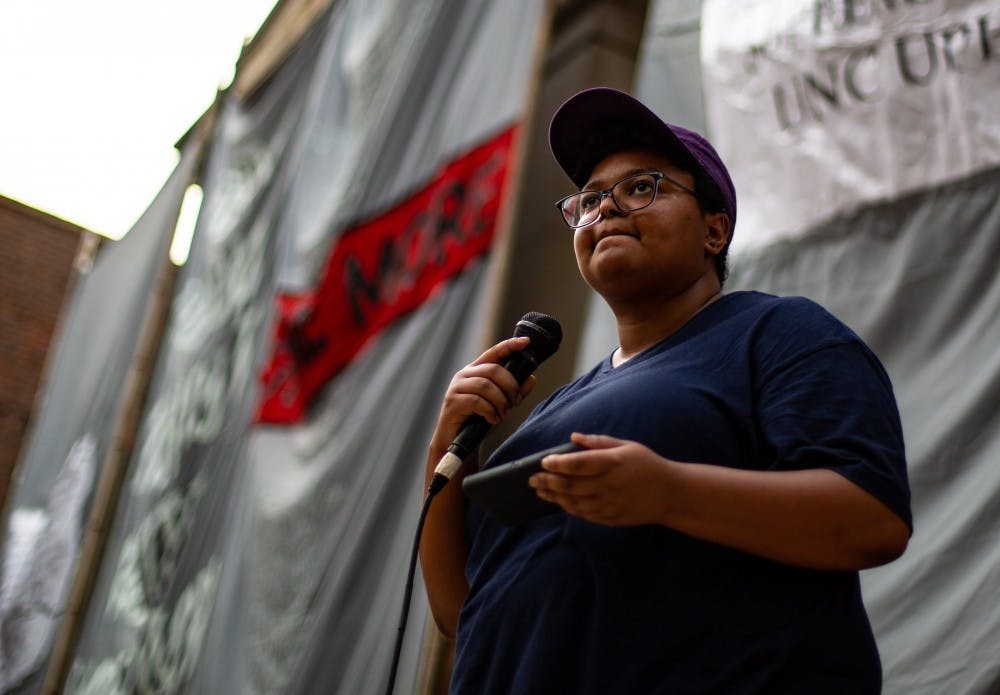ML: I wouldn’t know that.
DTH: Would you consider yourself an organizer?
ML: No, I wouldn’t.
DTH: We noticed yesterday that there was some red paint on your pants, is that significant in any way?
ML: These are the same pants I wore when I did my April 30 action.
DTH: Why did you wear them?
ML: I don’t have many pairs of pants, to be honest.
DTH: So, can we back up a little bit to the current criminal charges you’re facing from the April 30th incident? What are the next steps you’ll have to take with the legal system?
ML: Vandalism of a public monument, and I’m also facing honor charges from UNC which hasn’t been noted yet by The Daily Tar Heel, but I’m facing honor court charges that could result in my expulsion from the university.
DTH: So you’re still a student at the University?
ML: Yes, I am.
DTH: When is your honor court hearing?
To get the day's news and headlines in your inbox each morning, sign up for our email newsletters.
ML: That’s not been set yet.
DTH: When is the next hearing for your vandalism charge?
ML: Oct. 15 at 9 a.m.
DTH: Going back to the protest, how do you feel about the police presence and conduct?
ML: The police act as they always have around the monument, to protect the monument and not students or workers or people in the community. They acted very aggressively, very physically in the beginning, and were very physical. They stood guard around the monument. They did nothing to stop white supremacists who chose to get physical and were violent with anti-racist protesters. So the police responded at UNC as they always have around Silent Sam, by protecting the symbol to white supremacy rather than students.
DTH: Did you see any Confederate sympathizers?
ML: There were many Confederate sympathizers actually. And some of them got very violent with people.
DTH: Can you give any specific examples of when they got violent?
ML: I saw a Confederate sympathizer punch someone. They were very in our faces. I mean, they were doing as they always do. I mean, this is a group who organizes around white supremacist symbols, who has made threats against my life, against other students’ lives. They were there, they were present. Many of the anti-racist protesters who were at the demonstration also showed them that we are not afraid of them. We are not going to be cowered by them.
DTH: What are the next steps for protesters of Silent Sam?
ML: I think that we offered a number of alternatives to Silent Sam. One of those was the banners, which depicted memorials to people who have been murdered by white supremacy in this area, including James Lewis Cates, who was killed in 1970 in UNC’s Pit. There is not one existing monument to James Lewis Cates on our campus. There could be one put there. The only existing information about James Lewis Cates was a historical placard that we made and that was torn up by the police on April 30 after my action.
Again, when we talk about white supremacy happening, Silent Sam wasn’t an outlier. He wasn’t the most white supremacist, the only white supremacist thing at UNC, he wasn’t an outlier. He was a symbol of what goes on on the grounds, which is a lot of violence, a lot of disregard, a lot of denigration toward the Black people in this area and in this University. We are going to continue to keep pushing on that and pushing white supremacy out of UNC and out of our community, whether that comes to the exploitation of Black male student athletes who have a graduation rate of 48 percent at this University, despite annual revenues for sports being about $100,000,000.
We’re going to keep focusing on the ways that UNC is one of the few employers who doesn’t have a living minimum wage and how their workforce is largely Black and brown people who are being exploited by that. We can talk about the many ways in which police are used in Chapel Hill to target poor Black people on Franklin Street, to arrest them for things they wouldn’t arrest frat boys and other students for. The continued gentrification and raising of rent and push into historically Black neighborhoods with no concern for what’s going to happen to the residents of those neighborhoods.
These are all issues we’ve been talking about and working on since the beginning and what we’ve always said is the symbols we put in our public square reflects what happens on the ground. They reflect our law, our politics and our culture. Silent Sam was not just a figure, but he was the representation of the sanitized, clean-kept, garden white supremacy at UNC.
DTH: Just to be clear, the pedestal remaining on campus is something that you still oppose?
ML: I think they should take the pedestal down. I think that a memorial to the years of resistance the Black community has faced in Chapel Hill because of white supremacy would be a better, more fitting monument.
DTH: Is there anything else you’d like to add?
ML: What I think is important to note is that the students, workers and community in Chapel Hill, Durham and North Carolina took this upon themselves. Chancellor Folt did not do this. Chancellor Folt did not help us at all. UNC Police did not help us at all. Administrators, deans, Winston Crisp did not help us, in fact, they belittled us, they had officers surveil us. It was us who did this. We took it upon ourselves to try and make UNC a more fair equitable place. That’s something people are going to remember.
university@dailytarheel.com



